Airfirx 1/48 Checkertail Clan P-51D
The 325th Fighter Group arrived in North Africa in January 1943, when they flew their P-40Fs off USS Ranger. The group participated in some of the final fighting in Tunisia, then took part in the invasion of Sicily and moved to Italy following the invasion in September 1943. During this time, they adopted as the group marking a yellow-and-black checkerboard on the tail surfaces and became known as “The Checkertail Clan.”
In November 1943 the group was tranferred to the newly-formed 15th Air Force and equipped with the P-47D Thunderbolt, which they used for escort missions until March 1944 when they were re-equipped with the P-51B Mustang. Flying the Mustang, the group gave escort to B-17s and B-24s when the oil campaign began in April 1944 with missions flown against the Romanian oil fields at Ploesti. In massive air battles in April, May and June, the fighter groups of the 15th Air Force established air superiority over Romania by the time Romania left the Axis that August. During this time the 325th FG took part in two shuttle raids to the USSR.
The P-51Bs were replaced with P-51Ds in July 1944. Following the success of the oil campaign, the 15th Air Force concentrated their missions against targets in Austria, Hungary and southern Germany for the remainder of the war.
In January 1945, the group markings were expanded to cover the entire rear fuselage and tail surfaces of the P-51Ds, with the result that the “checkertail Clan” became the most colorfully-marked fighter group in the USAAF during the final months of the war.
THE KIT
When Airfix announced in 2015 that they would produce a new 1/48 P-51D Mustang, the event was met with yawns. “Another P-51?”
It's true, there are a lot of them out there. As Airfix released the CAD mockups, people began to take note, since the designers were catching things about the airplane other kits had ignored.
The end result in the box is a kit with early and late “bubble” canopies, and an accurately-shaped “Dallas” canopy; a choice of ventilation holes or louvres for the forward cowling; flaps that have no “ledge” when deployed (and the design is such one cannot get the wrong angle); landing gear designed to self-position at the correct angle (no more dangling main gear); a front windscreen that is a one-piece design with the fuselage, so there are no more gaps; correct main gear well with the main spar backing the whole thing; correct “early” and “late” dorsal fin options; all control surfaces are posable.
Cartograf decals for Donald Strait's 351st FG ‘Jersey J-e-r-k” and a 1st Air Commando Mustang are included.
So, is it indeed “a better mousetrap”? Read on.
CONSTRUCTION
Taking my time, and fitting parts carefully (not to mention following the instructions) I had the kit assembled in five hours, with no filler anywhere. Parts fit is precise. Be sure you trim off all little “sprue nubs.” The instructions are clear and easy to follow.
I prepainted the cockpit parts Dull Dark Green, with flat black for the fuel tank and the non-skid on the cockpit floor. Once assembled, the cockpit provides sufficient detail that when installed, I don't think you're really going to want to invest in a resin cockpit. I elected to do the model OOB (other than markings and decals), and painted the molded-on seat belts.
The wing is easily constructed, and it is nice to see that the main gear well - for the first time in any 1/48 Mustang kit - uses the main spar as the rear wall of the well throughout.
By providing two sets of flaps - one for “up, one for “down,” Airfix is able to offer flaps that in the “down” position do not have the “ledge” so familiar with the Tamiya kit. They have tabs that insure they're in the full-down position when installed.
Everyone normally has fits over getting the main gear legs positioned at the proper angle; failure to get it right is the major “fail” in Mustang models, even those built by “experts.” Airfix has designed this gear so that one sticks it in the hole and it is positioned at the right angle. No more hemming and hawing.
As with most injection-molded canopies, getting the canopy on this kit to sit properly in the open position is difficult due to the thickness of the part. The solution is easy: I scraped down the interior of the lower canopy frame from a point about 1/8-inch from the front, so that it was “knife-edge” thin. I then clipped the bottoms off either end of the canopy brace and attached it. With this, the canopy will easily “sit right” (i.e., on top of the fuselage not above it), and the flattened tips of the brace make a good attachment point.
Since I was doing a P-51D-10, I used the “early” dorsal fin. If you cannot distinguish the two, the early fin has a constantly-curved upper line in profile. You can also distinguish these parts by the fact the instructions call for you to use the other parts for the “late” dorsal fin.
The wing and fuselage assemblies came together with a satisfying “click” and there was no need for filler anywhere.
COLORS & MARKINGS
I painted the entire model with Tamiya Gloss Black. I then painted the wings with Vallejo “Dull Aluminum” to simulate the aluminum lacquer they were painted. The gun bay covers, ailerons and flaps were painted “white Aluminum,” while the fuselage was painted “Duraluminum” with “Dark Aluminum” around the exhausts.
I used the old Aeromaster sheet “Checkertail Clan” to do Group Commander William Beverly's “00". The Aeromaster checkertail decals included both colors. These were originally fitted for the Hasegawa P-51D, which is slightly different dimensionally than the Airfix kit. Fitting the fuselage and vertical fin decals involved a bit of “fiddling” to get them correctly aligned. The rest of the markings were also from the Aeromaster sheet, including the yellow wing stripes.
I unmasked the canopy and glued it in position, then assembled the main gear and attached each in position. The attachment is positive and there is no problem getting the correct angle for the gear legs. I then attached the exhaust stacks and prop and called it done.
CONCLUSIONS
The. Best. 1/48. P-51D. Available. Other modelers have claimed the Meng kit is equally good if not better. It is also twice as expensive for this kit. For the price, this Airfix kit represents excellent value for money (In the US, it is cheaper than the Tamiya kit by a good $5). In terms of what you get for the price you pay, this kit is hard to beat by anyone. Yes, Eduard's doing one next year they claim will be “definitive”, but for the price they'll charge, you'll be able to get three of these.
The kit is designed for easy construction. Any modeler from a beginner with a couple kits completed to someone like me who's been doing P-51s for mumblemumble years can follow the instructions in assembling this kit, secure in the knowledge they will have an excellent result.
This Mustang is Airfix's best kit to date. It could be the “license to print money” they hoped the early P-40 would be.
Buy In Confidence.
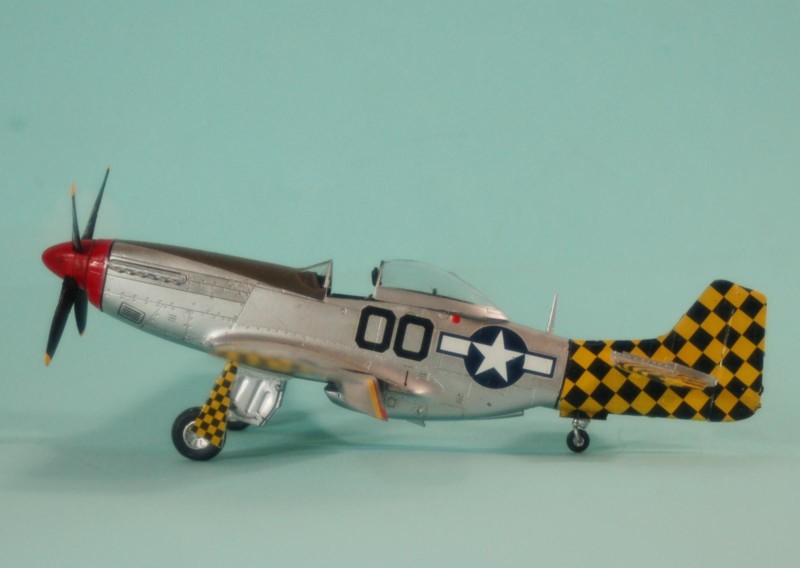
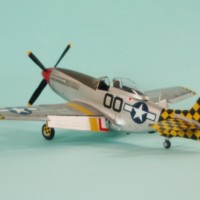
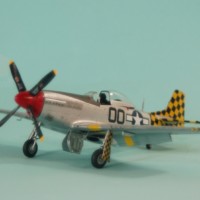
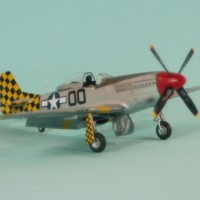
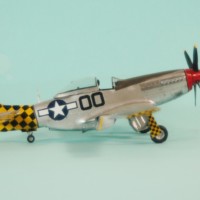
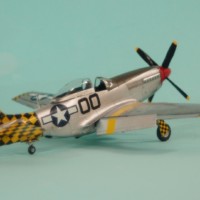
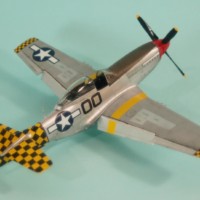
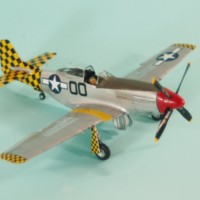

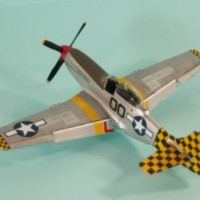
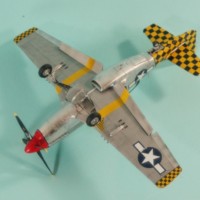
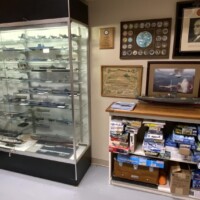

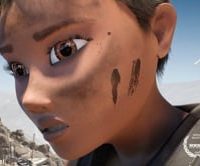
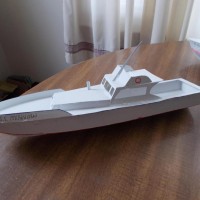
Can I ask WTH has "Mommy" all upset about the work "J-e-r-k"? Inquiring minds want to know. Can we modify "Mommy" to reflect that this is a site frequented by responsible adults?
Thanks Tom, great review. It certainly looks the part. The checkers look great seeing as you had to trim them.
I hope it sells as you say it should. I've started a British Tomahawk, that is going together very well.
It's a real beauty, the checquer came out very nice Tom! The weathering is nice too. Congrats!
That's a really nice looking pony Tom.
I can but only concur with the masses on this one, TC - a most definitive review and build.
And a nice touch with the "mumblemumble" blurb - good one.
Something that doesn't always get touched upon...wheel well colors or lack of for the P-51. What are the appropriate colors for the wheel wells? Other forms have recommended that only the rear spar be painted chromate yellow with the remainder of the well being natural metal. Yet we modelers seem to always paint the whole well and nothing but, the well in chromate green or yellow in it's entirety. I know company spec's called out for the wells to be painted. Other photos depending on the production run show them unpainted or where they painted in a silver dope color? Is this a case of your mileage may very? Inquiring minds need to know.
That last sentence is not a dig ...I didn't read the beginning of the string until after the fact.
For WW2 Mustangs, the wheel well is painted aluminum lacquer also the innner sides of the gear doors, while the main spar is Yellow Zinc Chromate. When they were refurbished the entire wheel well got painted YZC/Interior green
Awesome build Tom, it’s easily one of the most colourful P-51 I’ve seen.
2 things pop up in my mind: getting those checker decals align and settled down must have been hard work; and also the fact that I’ve seeen several models which have the guns access panels painted in a dark shade aluminium. Since I know zero of NMF shades reading your detailed description of your chosen shades for this model will be my guideline when I come around this little gem of Airfix
Great article Tom and a cracking build.
Nice work, Tom. It must be selling well as they’re releasing two more boxings of it in 2018.
And likely the P-51D-5 early version by the end of the year.
Great job, Tom...Both on the build and also on the write-up. The only drawback that I see is that now I'll have to get one to go with all my Me 109's and Fw 190's. Cheers.
Nice looking Mustang Tom. My new Airfix Mustang kit arrived in the mail a few days ago. After looking inside the box, I may have to get one or two more... Thanks for the building information as well as a nice history lesson on the 325th. I really liked the new 1/48 P-40 they released too... it builds into a very nice model right out of the box. Airfix is definitely back... and that's a good thing.
Oh yeah - I am the modeler I am because of good old Airfix, and now that they're doing what they're doing, Airfix is back and I am back to Airfix!
A good positive review straight to the point. As to the pricing it depends on where in the world you live. Here in China the Airfix kit doesn't seem to be available at present but the P40 is about 26 usd, the Meng Mustang is 19 usd and the Tamiya 16 usd, as for Eduard, judging by the price of their after market kits the price would be very high in comparison. I expect import taxes have something to do with it...
That sounds right. Of course China wouldn't tax Meng.
Well, this is a great review and a beautiful bird. Great Mustang, Tom! I just got one of these a couple days ago & it is better than any other kit I have ever seen - but my experience with modern kits is far below that of most here. I look forward to doing mine, thanks to this and other reviews. (Not to mention my love of anything "Mustang!")
Bravo!
Another beauty!